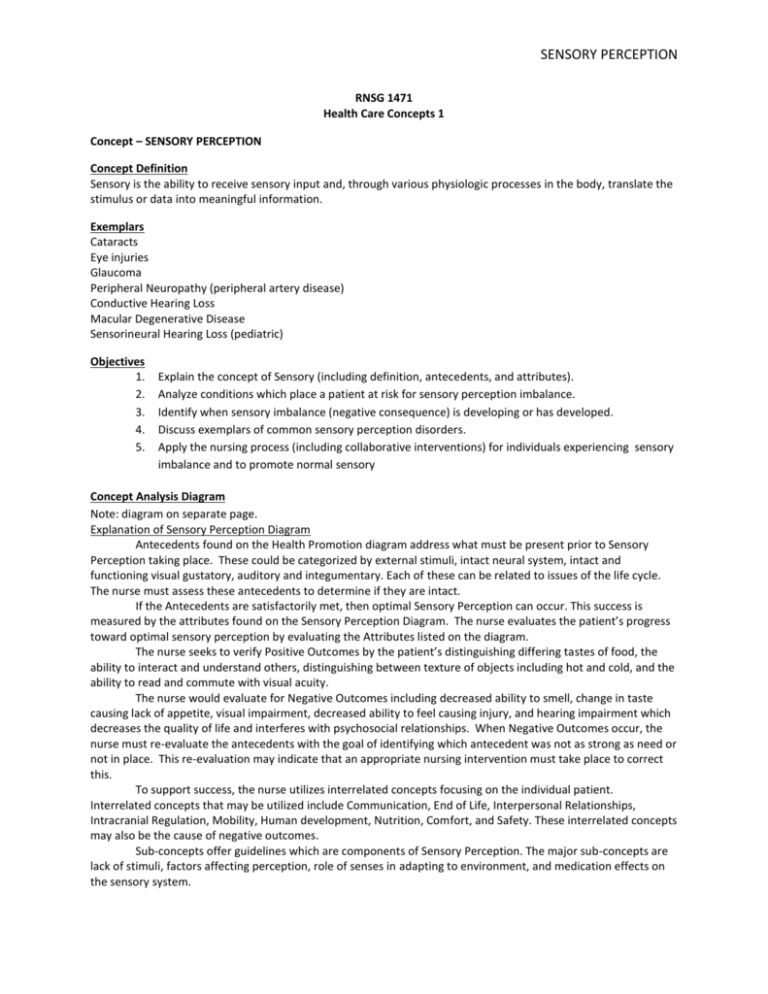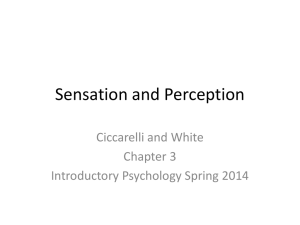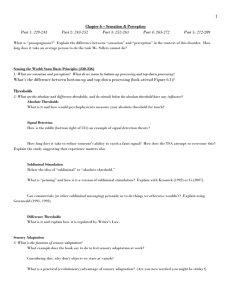Sensory Perception - Trinity Valley Community College
advertisement

SENSORY PERCEPTION RNSG 1471 Health Care Concepts 1 Concept – SENSORY PERCEPTION Concept Definition Sensory is the ability to receive sensory input and, through various physiologic processes in the body, translate the stimulus or data into meaningful information. Exemplars Cataracts Eye injuries Glaucoma Peripheral Neuropathy (peripheral artery disease) Conductive Hearing Loss Macular Degenerative Disease Sensorineural Hearing Loss (pediatric) Objectives 1. 2. 3. 4. 5. Explain the concept of Sensory (including definition, antecedents, and attributes). Analyze conditions which place a patient at risk for sensory perception imbalance. Identify when sensory imbalance (negative consequence) is developing or has developed. Discuss exemplars of common sensory perception disorders. Apply the nursing process (including collaborative interventions) for individuals experiencing sensory imbalance and to promote normal sensory Concept Analysis Diagram Note: diagram on separate page. Explanation of Sensory Perception Diagram Antecedents found on the Health Promotion diagram address what must be present prior to Sensory Perception taking place. These could be categorized by external stimuli, intact neural system, intact and functioning visual gustatory, auditory and integumentary. Each of these can be related to issues of the life cycle. The nurse must assess these antecedents to determine if they are intact. If the Antecedents are satisfactorily met, then optimal Sensory Perception can occur. This success is measured by the attributes found on the Sensory Perception Diagram. The nurse evaluates the patient’s progress toward optimal sensory perception by evaluating the Attributes listed on the diagram. The nurse seeks to verify Positive Outcomes by the patient’s distinguishing differing tastes of food, the ability to interact and understand others, distinguishing between texture of objects including hot and cold, and the ability to read and commute with visual acuity. The nurse would evaluate for Negative Outcomes including decreased ability to smell, change in taste causing lack of appetite, visual impairment, decreased ability to feel causing injury, and hearing impairment which decreases the quality of life and interferes with psychosocial relationships. When Negative Outcomes occur, the nurse must re-evaluate the antecedents with the goal of identifying which antecedent was not as strong as need or not in place. This re-evaluation may indicate that an appropriate nursing intervention must take place to correct this. To support success, the nurse utilizes interrelated concepts focusing on the individual patient. Interrelated concepts that may be utilized include Communication, End of Life, Interpersonal Relationships, Intracranial Regulation, Mobility, Human development, Nutrition, Comfort, and Safety. These interrelated concepts may also be the cause of negative outcomes. Sub-concepts offer guidelines which are components of Sensory Perception. The major sub-concepts are lack of stimuli, factors affecting perception, role of senses in adapting to environment, and medication effects on the sensory system. SENSORY PERCEPTION Assignments Prior to class: 1. Review definitions of inter-rated concepts on concept analysis diagram. 2. Review concept analysis diagram. 3. Review anatomy and physiology of the eye, ear, and peripheral nerves. 4. Review assigned reading: Berman, A. & Snyder, S. (2012). Kozier & Erb’s Fundamentals of Nursing. Boston: Pearson. Chapter 38: Sensory Perception Giddens, J.F. (2013). Concepts for nursing practice. St. Louis. MO: Mosby Elsevier. Chapter 25: Sensory Perception Lewis, S.L., Heitkemper, M.M., Dirksen, S.R., O’Brien, P.G., & Bucher, L. (2011). Medical surgical nursing (8th ed). St. Louis: Mosby Elsevier. Chapter 21: Nursing Assessment: Visual Auditory Systems Chapter 22: Nursing Management: Visual and Auditory Problems McKinney, E, James, S., Murray, S., Nelson, K., & Ashwill, J. (2013). Maternal-child nursing (4th ed). St. Louis: Elsevier Saunders. Chapter 55: The Child with a Sensory Alteration. 5. Video and Internet resources to review: Visual Impairment http://mcom.alexanderstreet.com.proxy.tvcc.edu:2048/view/1665460 Understanding How Aging Can Affect Your Family Member http://mcom.alexanderstreet.com.proxy.tvcc.edu:2048/view/1665629 Before Help Arrives http://mcom.alexanderstreet.com.proxy.tvcc.edu:2048/view/1665621 Central Nervous System, The Senses and Emotions http://mcom.alexanderstreet.com.proxy.tvcc.edu:2048/view/1941086 Sensorineural Hearing Loss http://www.youtube.com/watch?v=DzapIm7b1MQ. 6. Review the following Nursing Diagnoses Sensory Perception Disturbance (specify: visual, auditory, kinesthetic, gustatory, tactile, olfactory) Altered role performance (specify: visual, auditory, kinesthetic, gustatory, tactile, olfactory) Social Isolation (specify: visual, auditory, kinesthetic, gustatory, tactile, olfactory) Body Image disturbance (specify: visual, auditory, kinesthetic, gustatory, tactile, olfactory) Impaired Communication (specify: visual, auditory, kinesthetic, gustatory, tactile, olfactory) SENSORY PERCEPTION Concept content outline: Concept: Sensory Perception Sub Concepts: Lack of Stimuli Factors Affecting Perception Role of Senses in Adapting to Environment Antecedents: External Stimuli Intact Neural system Intact and Functioning, Visual, Gustatory, Auditory and Integumentary Risk Factors: Elderly population Adverse reaction to medication Complication from medical Lifestyle choices – smoking Occupation - loud noise, certain chemicals, and flying debris Assessment: Comprehensive history Physical assessment Physical and psychological clinical manifestations Diagnostic tests Positive Outcomes: Enjoy taste of food Interact to/with others with understanding Distinguish between sharp and blunt objects, hot and cold Ability to read and commute through visual acuity Negative Outcomes: Physiological Psychological Clinical Management: Nursing interventions Collaborative interventions Pharmacological therapy Procedural therapies Diagnostic studies Exemplars: Cataracts Eye injuries Glaucoma Peripheral Neuropathy (peripheral artery disease) Conductive Hearing Loss Macular Degenerative Disease Sensorineural Hearing Loss (pediatric) SENSORY PERCEPTION CONCEPT ANALYSIS DIAGRAM (TEXAS) – SENSORY PERCEPTION Nursing Care Directed toward what contributes to a normal concept and is thereby related to all factors involved in or with the concept. Attributes Defining characteristics of the concept What must occur for the concept to exist Antecedents What precedes the concept for it to exist Events or incidents that must happen before the concept Consequences Untoward events or outcomes that occur due to malfunction within the concept Positive events or outcomes that occur due to proper functioning within the concept Interrelated Concept Concepts which can affect change in the other Concepts which work together to ensure a normal process Concepts which if depleted or impaired can cause a negative consequence in the other Sub- Concept Critical components of major concept Attributes Hearing: Normal Hearing Range in Nursing Care End of Life Communication Adults is from 0 dB Hearing Level to 25 dB Hearing Level, Vision: Visual acuity 20/20: Integumentary System: Intact Gustatory: Sensations that Process Taste (Sweet, Salt, Sour and Bitterness) Olfactory: Odorants are Sensed Interpersonal Relationships Intracranial Regulation Interrelated Concepts Mobility Human Development Antecedents Safety External Stimuli, Intact Neural System Intact and Functioning, Visual, Gustatory, Auditory and Integumentary Note: All of the Above Can Be Related to Issues of the Life Cycle Nutrition Sensory Perception The ability to receive sensory input and through various physiological processes in the body, translate the stimulus or data into meaningful information Decreased Ability to Smell (Consume Spoiled Food) Consequences (Outcomes) Change in Taste (Lack of Appetite) Negative Lack of Stimuli Factors Affecting Perception Comfort Sub Concepts Visual Impairment (Accidents) Enjoy Taste of Food Positive Decreased Ability to Feel (Thermal Injury) Interact to/with Others with Understanding Hearing Impairment Role of Senses in Adapting to Environment Distinguish Between Sharp and Blunt Objects or Hot Medication Effects and Cold by Touch Ability to Read and Commute Through Visual acuity Decreased Quality of Life/ Psychosocial Issues







